Sabona Wildlife Safari Day 1

Take Off
Jörgen Wennberg
Mon 18 Dec 2017 12:00
DAY 1 We drove from Cape Town approx 2,5 hrs East towards Montagu. Our friend Alexandra Malmnäs recommended us this Private Game Reserve. Entering the Game Reserve we encountered this first sign…. 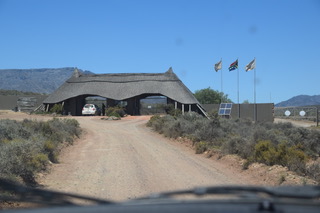 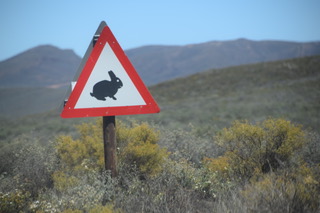 A zebra welcoming us! Long route to the Lodge. The vastness of this area really caught our admiration as the “nuditity” of the landscape.   Kudu antilop of South Africa. Our Lodge   At the foot of the towering Warmwaterberg Mountains in the Little Karoo lies the safari destination of Sanbona Wildlife Reserve. Lodges and an adventurous Explorer Camp nestle in 58, 000 hectares of sculpted Cape Fold Mountains and wide-open plains. We experienced a huge diversity of indigenous flora and fauna and rare examples of San rock art, some dating back more than 3, 500 years. Conservation is paramount at Sanbona and every guest contributes to preserving this wilderness for future generations. It's the vastness of the landscape, the alluring stillness and isolation amid raw beauty and boundless plains that make Sanbona unique. Lodge Gondwana  After lunch we had our first tour out in the wild before sunset. 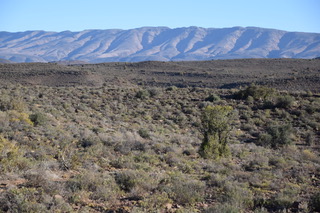  The luck was really on our side as the first animals we met was the King: the Lions. Resting in harmony in the Bush. The lion is a large cat of the genus Panthera native to Africa and India. It has a muscular, broad-chested body, short, rounded head, round ears, and a hairy tuft at the end of its tail. It is sexually dimorphic; adult male lions are larger than females and have a prominent mane. It is a social species, forming groups called prides. A lion's pride consists of a few adult males, related females, and cubs. Groups of female lions usually hunt together, preying mostly on large ungulates. The lion is an apex and keystone predator; although some lions scavenge when opportunities occur and have been known to hunt humans, the species typically does not actively seek out and prey on humans. The lion inhabits grasslands, savannas and shrublands. It is usually more diurnal than other wild cats, but when persecuted, it adapts to being active at night and at twilight. During the Neolithic period, the lion ranged throughout Africa, Southeast Europe, the Caucasus, and Western and South Asia, but it has been reduced to fragmented populations in sub-Saharan Africa and one population in western India. It has been listed as Vulnerable on the IUCN Red List since 1996 because populations in African countries have declined by about 43% since the early 1990s. Lion populations are untenable outside designated protected areas. Although the cause of the decline is not fully understood, habitat loss and conflicts with humans are the greatest causes for concern. One of the most widely recognised animal symbols in human culture, the lion has been extensively depicted in sculptures and paintings, on national flags, and in contemporary films and literature. Lions have been kept in menageries since the time of the Roman Empire and have been a key species sought for exhibition in zoological gardens across the world since the late 18th century. Cultural depictions of lions were prominent in Ancient Egypt, and depictions have occurred in virtually all ancient and medieval cultures in the lion's historic and current range. 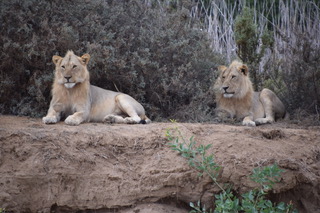  Just around the corner we me the Rhinos! As much mellow as the Lions.   Further out we saw first a South African Elan and then a Kudu Antilop.  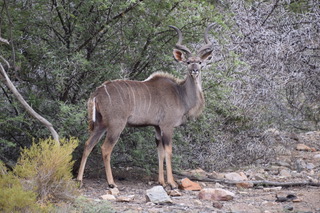 The nature was really breathtaking, especially at sunset.   We had a sunset stop where the kids enjoyed time with their bigger brothers.   And we had a well deserved sundowner. From Sundowner on the boat to Sundowner at the Safari.     Enjoying the Wildlife 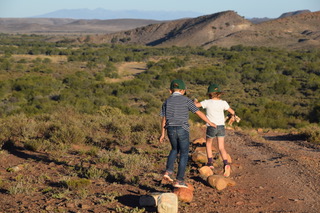 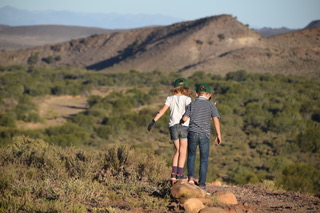     Beautiful sunset in the wild   Morfar making fun of Inez    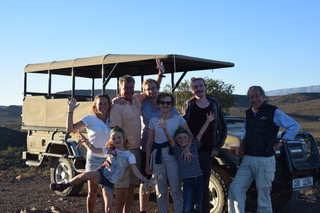 On the road we went again.         |